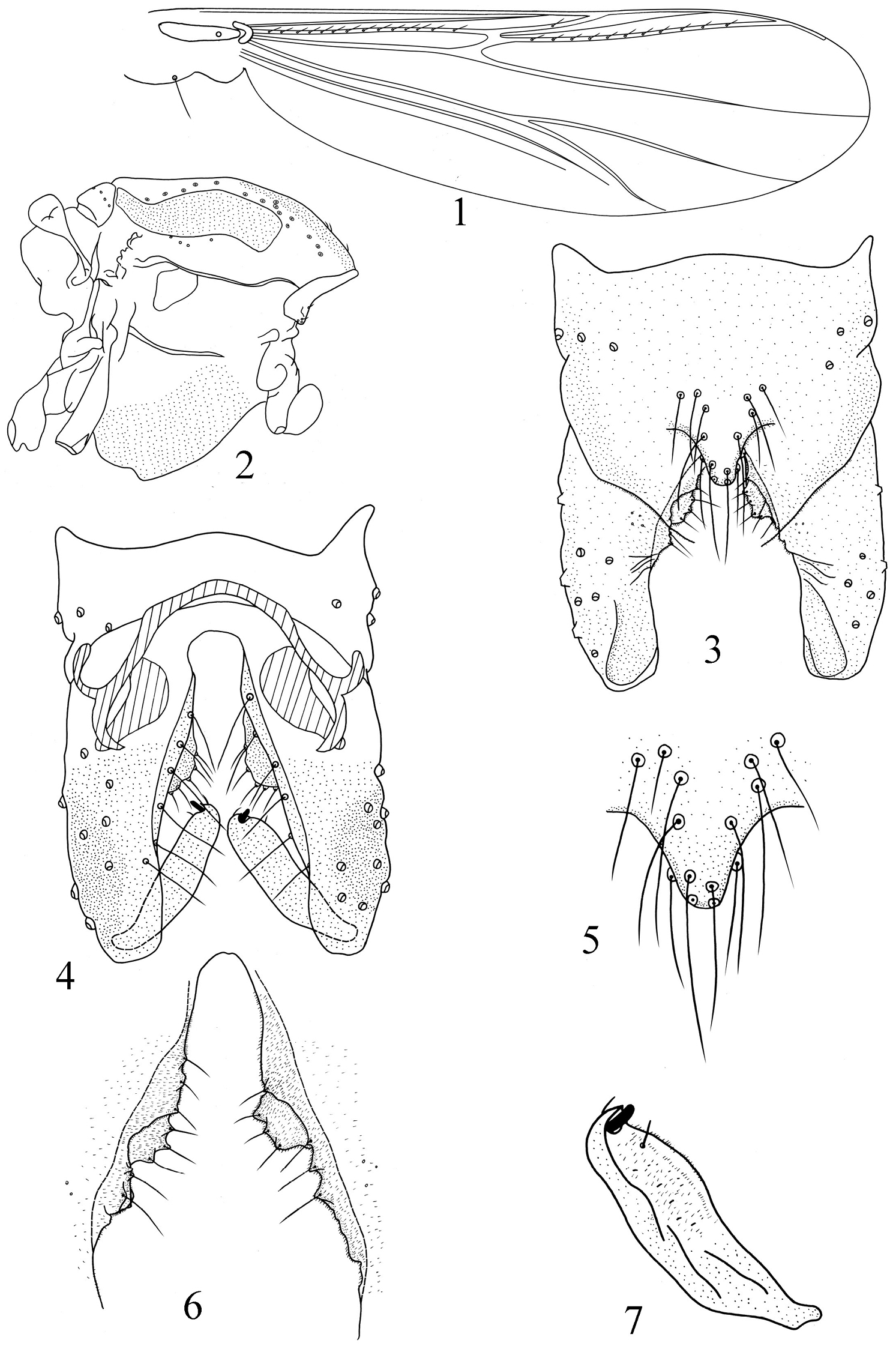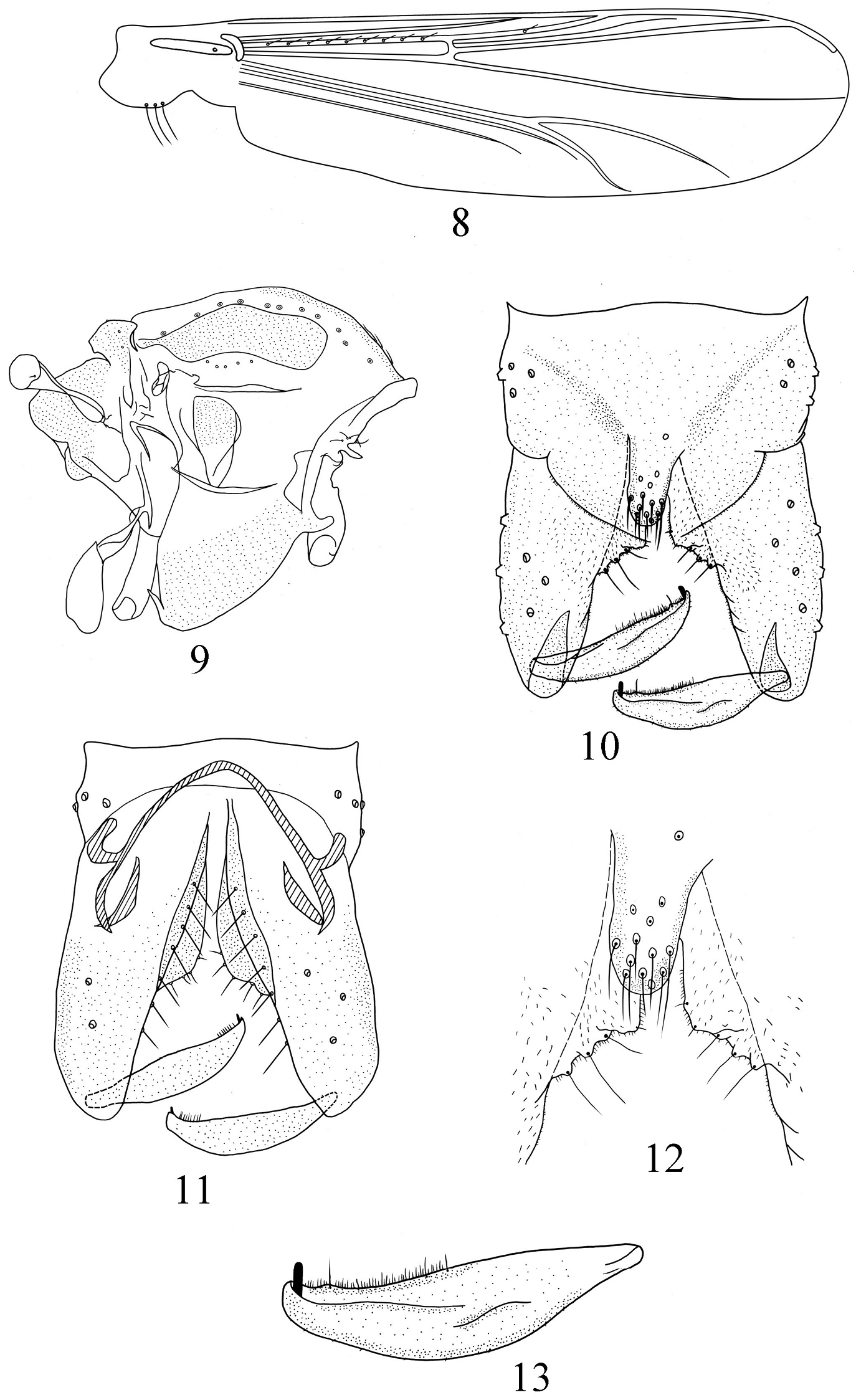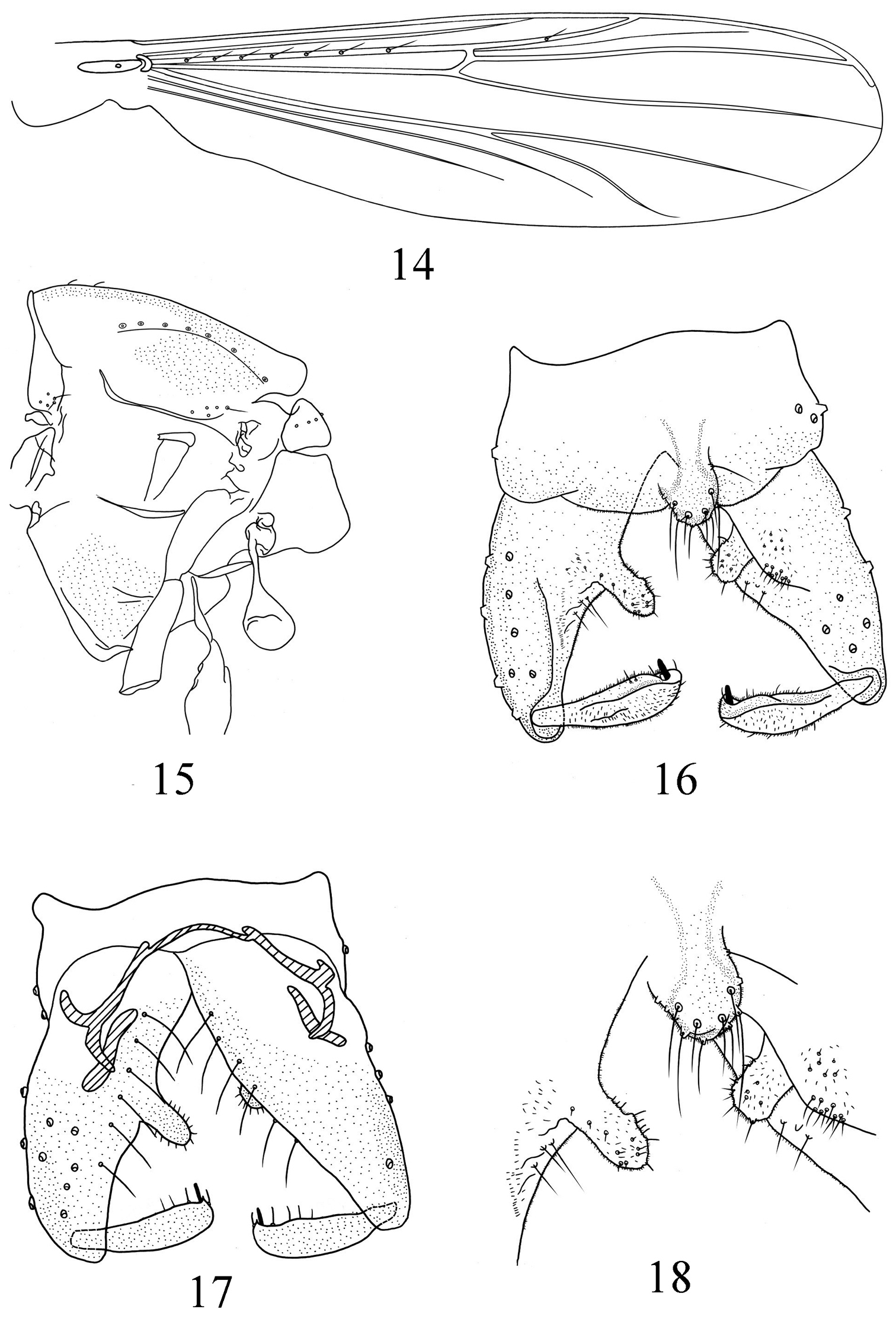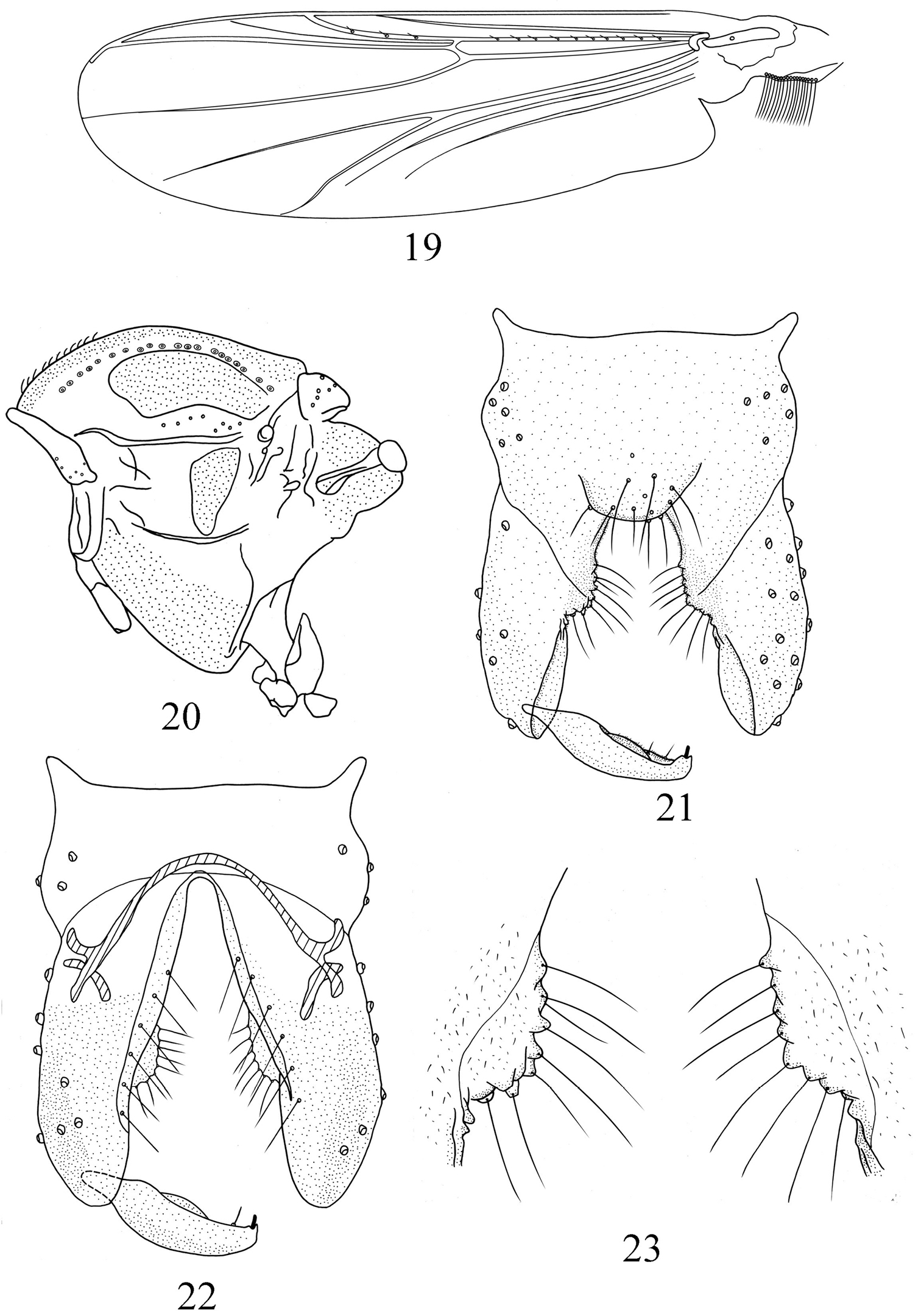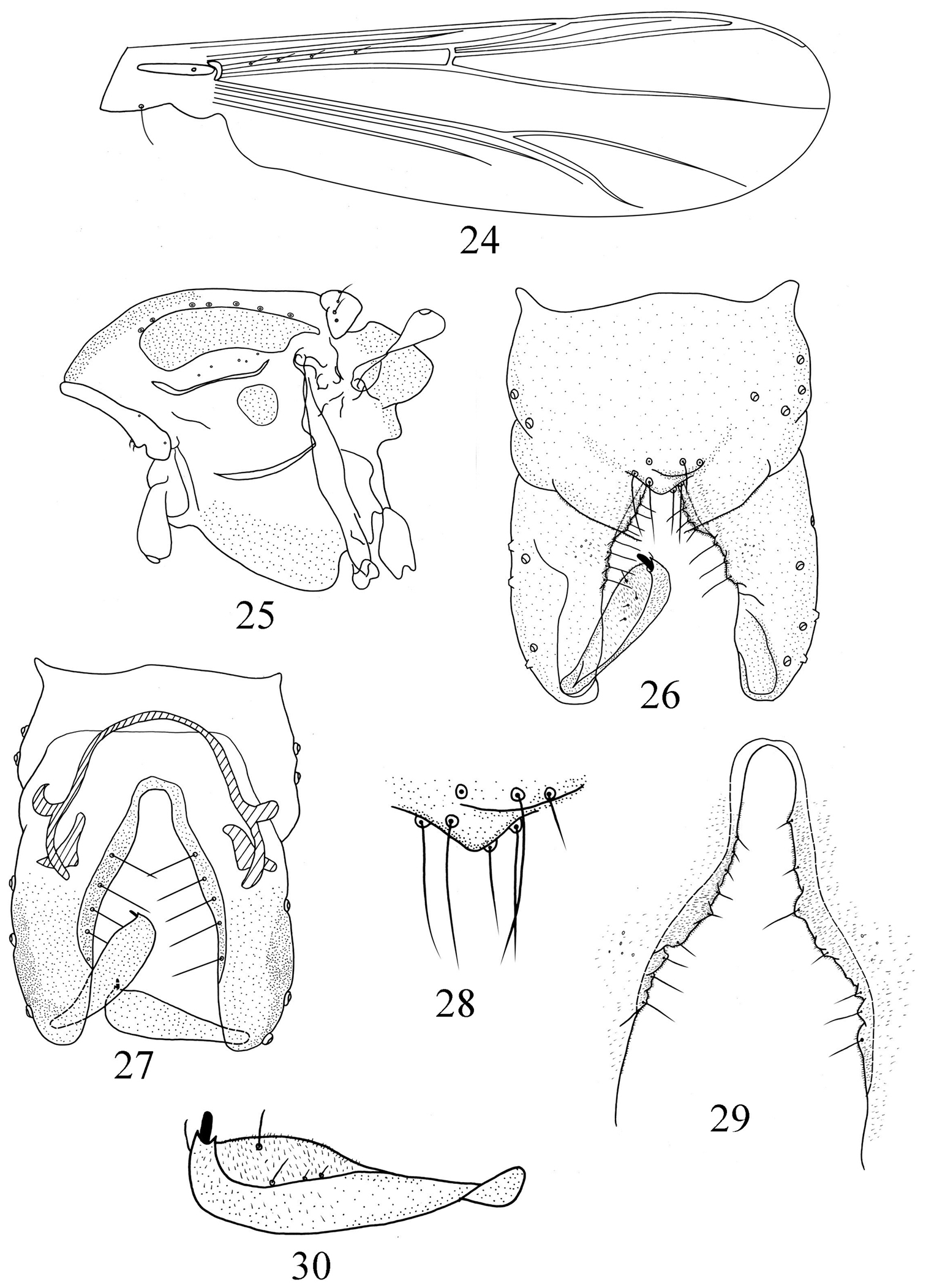






Citation: Ren J, Lin X, Wang X (2014) Review of genus Pseudorthocladius Goetghebuer, 1943 (Diptera, Chironomidae) from China. ZooKeys 387: 51–72. doi: 10.3897/zookeys.387.5808
The genus Pseudorthocladius Goetghebuer, 1943 from China, including 12 species, is reviewed. Five new species, P. (P.) binarius sp. n., P. (P.) cylindratus sp. n., P. (P.) digitus sp. n., P. (P.) ovatus sp. n. and P. (P.) paucus sp. n. are described and illustrated as adult males. P. (P.) cristagus Stur & Sæther, 2004, P. (P.) jintutridecima (Sasa, 1996), P. (P.) macrovirgatus Sæther & Sublette, 1983, P. (P.) morsei Sæther & Sublette, 1983, P. (P.) uniserratus Sæther & Sublette, 1983, P. (L.) wingoi Sæther & Sublette, 1983 are newly recorded in Oriental Region. A key to the males of Pseudorthocladius in China is presented.
Chironomidae, Pseudorthocladius, new species, new record, key, Oriental, China
The genus Pseudorthocladius Goetghebuer, 1943 contains two subgenera, Pseudorthocladius Goetghebuer and Lordella Sæther & Sublette (
The subgenus Lordella shows some similarities and possible synapomorphies with Doithrix, such as the basally widened gonostylus and hook–shaped inferior volsella. However, the long anal point and setae on the point indicating an intermediate position between typical Pseudorthocladius s. str. and Doithrix. So the status of subgenus Lordella needs to be further discussed.
The immatures of Pseudorthocladius are found in a wide variety of damp habitats including mosses, hygropetric regions, seeps and floodplains along stream banks (
According to
In this paper, the Pseudorthocladius based on material from China is reviewed. Five new species are described, six species are newly recorded in China, and key to the Chinese species of Pseudorthocladius is presented.
The morphological nomenclature follows
http://zoobank.org/D5AC53EC-771A-4D91-ADF2-B3EB97CDF0FD
http://species-id.net/wiki/Pseudorthocladius_binarius
Figures 1–7The male imago can be distinguished from the known species of the genus by the following combination of characters: low AR (0.29); squama with few setae; anal lobe reduced; inferior volsella has two sub–lobes; virga absent.
Adult male (n = 4). Total length 1.50–1.80, 1.63 mm. Wing length 0.81–0.97, 0.89 mm. Total length/wing length 1.83–1.86, 1.84. Wing length/length of profemur 2.26–2.43 (3).
Coloration. Head, abdomen, legs brown; thorax with yellow ground with brown postnotum and preepisternum.
Head. Antenna with 13 flagellomeres. Terminal flagellomere length 95–108, 105 μm. AR 0.28–0.33, 0.29. Temporal setae 8 (2), including 2 (2) inner verticals, 3–4 (3) outer verticals, and 2 (2) postorbitals. Clypeus with 6–10, 8 setae. Tentorium 86–96, 92 μm long, 14–19, 15 μm wide. Palpomere lengths (in μm): 19–24, 22; 26–29, 28; 55–62, 59; 84–91, 86; 98–120, 110. L: 5th/3rd 1.77–2.10, 1.86.
Wing (Figure 1). VR 1.25–1.29 (3). Anal lobe reduced. Brachiolum with 1 seta; R with 9–15, 13 setae; R1 with 1–4, 2 setae; R4+5 9–11, 10 setae; M with 0–1, 1 seta. Squama with 1–2, 1 seta. Costal extension 70 μm long. Cu1 slightly curved.
Pseudorthocladius (Pseudorthocladius) binarius sp. n., male. 1 wing 2 thorax 3 hypopygium (dorsal view) 4 hypopygium (ventral view) 5 anal point 6 inferior volsella 7 gonostylus.
Thorax (Figure 2). Antepronotum with 3–6, 5 lateral setae, dorsocentrals 13–15, 13, acrostichals 3–7, 5, prealars 4–6, 5. Scutellum with 6–8, 7 setae.
Legs. Pulvilli present. Spur of fore tibia 29 (3) μm long, spurs of mid tibia 22–24, 23 μm and 16–19, 18 μm long; hind tibia with a long spur 40–43, 42 μm long, a short spur 14–17, 16 μm long and comb composed of 10–12, 11 spines. Width at apex of fore tibia 24–28, 26 μm, of mid tibia 20–26, 24 μm, of hind tibia 31–36, 33 μm. Lengths (in μm) and proportions of legs as in Table 1.
Lengths (in μm) and proportions of legs of Pseudorthocladius (Pseudorthocladius) binarius sp. n.
| p1 | p2 | p3 | |
|---|---|---|---|
| fe | 350–400 (3) | 350–400, 375 | 360–400, 380 |
| ti | 340–420 (3) | 350–430, 373 | 410–500, 435 |
| ta1 | 250–300 (2) | 125–150, 131 | 220–260, 240 |
| ta2 | 170–210 (2) | 72–96, 78 | 115–130, 124 |
| ta3 | 120–140 (2) | 60–72, 63 | 105–126, 115 |
| ta4 | 72–84 (2) | 36–48, 42 | 48–60, 53 |
| ta5 | 51–67 (2) | 48–50, 49 | 48–60, 54 |
| LR | 0.71 (2) | 0.33–0.37, 0.35 | 0.52–0.56, 0.55 |
| BV | 2.22–2.30, 2.29 | 3.63–3.98, 3.71 | 2.98–3.13, 3.02 |
| SV | 2.73–2.80, 2.76 | 5.53–5.72, 5.62 | 3.32–3.50, 3.41 |
| BR | 2.50–2.60, 2.56 | 3.14–3.67, 3.45 | 3.75–4.38, 4.03 |
Hypopygium (Figures 3–7). Laterosternite IX with 4–6, 5 setae. Anal point (Figure 5) subtriangular with rounded apex, 24–26, 25 μm long, with 13–15, 14 strong setae. Phallapodeme 22–24, 24 μm long. Transverse sternapodeme 44–50, 48 μm long. Virga absent. Gonocoxite 110–122, 118 μm long. Inferior volsella (Figure 6) with two sub–lobes, the dorsal lobe with concave inner margin and 4–5, 5 marginal setae, the ventral lobe semi–rounded with 3–4, 3 marginal setae. Gonostylus (Figure 7) 60–67, 64 μm long, narrowed at base. Megaseta 9–10, 10 μm long. HR 1.82–1.92, 1.85. HV 2.43–2.48, 2.45.
Female, pupa and larva unknown.
Holotype: ♂ (BDN No.20200), China, Fujian, Quanzhou City, Dehua County, Daiyun Mountain, 25°40'N, 118°11'E, 13.ix.2002, Zheng Liu, sweep net. Paratypes: 3 ♂♂, as holotype.
The specific name is from Latin, binarius, meaning “of two”, referring to the inferior volsella has two sub–lobes.
The new species resembles Pseudorthocladius (Pseudorthocladius) tusimoquereus Sasa & Suzuki (1999) in the structure of hypopygium, but can be separated from the latter on the following points: (1) Pseudorthocladius (Pseudorthocladius) binarius sp. n. has small body size (1.63 mm) and low AR (0.29); (2) wing anal lobe reduced and squama with few setae; (3) inferior volsella with two sub–lobes; (4) virga absent.
The new species is collected in a subtropical mountain area in Fujian Province (Oriental China).
http://species-id.net/wiki/Pseudorthocladius_cristagus
The male imago is separable from the other species of the genus Pseudorthocladius by having hairy wings, strong crista dorsalis and outer heel of the gonotylus.
China, Zhejiang: 1 ♂ (BDN No.K5B50), Taizhou City, Tiantai County, Huading Mountain, 29°15'45"N, 121°06'36"E, 13.iv.2011, Xiaolong Lin, sweep net.
Differences between the specimens from China and Luxemburg.
| Chinese specimen | Luxemburg specimens | |
|---|---|---|
| TL | 2.48 mm | 3.35–3.41 mm |
| WL | 1.63 mm | 1.89–2.02 mm |
| AR | 1.05 | 1.08–1.14 |
| LR1 | 0.62 | 0.75–0.76 |
Zhejiang Province (Oriental China); Luxemburg.
http://species-id.net/wiki/Pseudorthocladius_curtistylus
AR 0.45–0.70; dorsocentrals 15–18; R with 9–13 setae, R1 with 2–3 setae, R4+5 with 0–14 setae; squama with 3–4 setae; virga present. Type I with low and extending crista dorsalis, type II with crista dorsalis absent, type III with round and protruding crista dorsalis.
China, Zhejiang: 3 ♂♂, Wenzhou City, Taishun County, 27°33'N, 119°39'E, 1.viii.2005, Xin Qi, light trap; Tianmu Mountain, 30°19'N, 119°26'E, 23.vi.1998, Bingchun Ji, sweep net. Fujian: 10 ♂♂, Wuyi City, Wuyi Mountain, 27°45'N, 118°03'E, 30.iv.1993, Xinhua Wang, sweep net. Guangdong: 5 ♂♂, Fengkai County, 23°24'N, 111°30'E, 20.iv.1988, Xinhua Wang, sweep net. Yunnan: 2 ♂♂, Dali Bai Autonomous Prefecture, Cang Mountain, Qingbi River, 25°36'N, 100°15'E, 23.v.1996, Yuzhou Du, light trap. Hunan: 2 ♂♂, Zhuzhou City, Yanling County, 26°27'N, 113°42'E, 16.vii.2004, Chuncai Yan, sweep net.
The Chinese specimens agree with the description of Pseudorthocladius (Pseudorthocladius) curtistylus type II and type III. According to
The species is widely distributed in Holarctic region.
http://zoobank.org/399C86DD-F23B-4C2B-9E9F-E8711959DCA2
http://species-id.net/wiki/Pseudorthocladius_cylindratus
Figures 8–13The male imago can be distinguished from the known species of the genus by the following combination of characters: cylindrical anal point; well–developed triangular inferior volsella; low AR (0.66) and high VR (1.37).
Adult male (n = 6). Total length 1.68–1.97, 1.87 mm. Wing length 1.04–1.19, 1.15 mm. Total length/wing length 1.53–1.75, 1.63. Wing length/length of profemur 2.64–2.88, 2.71.
Coloration. Head, abdomen, legs light brown; thorax with light brown ground with brownish black postnotum and preepisternum.
Head. Antenna with 13 flagellomeres. Terminal flagellomere length 235–264, 254 μm. AR 0.65–0.67, 0.66. Temporal setae 8–10, 9, including 3–6, 4 inner verticals, 4–5, 5 outer verticals, and 0–2, 1 postorbital. Clypeus with 8–11, 10 setae. Tentorium 96–113, 103 μm long, 18–21, 19 μm wide. Palpomere lengths (in μm): 22–26, 24; 24–28, 26; 60–72, 65; 84–91, 86; 113–137, 130. L: 5th/3rd 1.87–2.28, 2.00.
Wing (Figure 8). VR 1.33–1.43, 1.37. Anal lobe obtuse. Brachiolum with 1 seta; R with 5–13, 9 setae; R1 with 1–4, 2 setae; other veins bare. Squama with 1–3, 2 setae. Costal extension 80–84, 81 μm long. Cu1 slightly curved.
Pseudorthocladius (Pseudorthocladius) cylindratus sp. n., male. 8 wing 9 thorax 10 hypopygium (dorsal view) 11 hypopygium (ventral view) 12 anal point and inferior volsella 13 gonostylus.
Thorax (Figure 9). Antepronotum with 4–6, 5 lateral setae, dorsocentrals 9–13, 11, acrostichals 3–7, 5, prealars 3–5, 4. Scutellum with 4–5, 5 setae.
Legs. Pulvilli present. Spur of fore tibia 29–41, 34 μm long, spurs of mid tibia 19–29, 22 μm and 19 μm long; hind tibia with a long spur 36–41, 38 μm long, a short spur 24–31, 27 μm long and comb composed of 10–12, 11 spines. Width at apex of fore tibia 34–46, 37 μm, of mid tibia 29–31, 30 μm, of hind tibia 31–36, 33 μm. Lengths (in μm) and proportions of legs as in Table 3.
Lengths (in μm) and proportions of legs of Pseudorthocladius (Pseudorthocladius) cylindratus sp. n.
| p1 | p2 | p3 | |
|---|---|---|---|
| fe | 400–450, 423 | 440–500, 466 | 430–490, 456 |
| ti | 340–380, 360 | 440–510, 477 | 520–570, 530 |
| ta1 | 420–460, 437 | 200–220, 210 | 310–340, 323 |
| ta2 | 264–280, 271 | 150–175, 163 | 156–180, 171 |
| ta3 | 180–190, 183 | 142–178, 152 | 140–144, 142 |
| ta4 | 98–101, 100 | 52–72, 68 | 67–74, 72 |
| ta5 | 67–72, 69 | 48–55, 51 | 45–55, 52 |
| LR | 1.11–1.23, 1.19 | 0.46–0.59, 0.50 | 0.60–0.62, 0.61 |
| BV | 1.64–1.90, 1.86 | 2.86–3.80, 2.89 | 2.92–3.04, 2.95 |
| SV | 1.74–1.80, 1.76 | 4.03–4.45, 4.28 | 3.00–3.05, 3.02 |
| BR | 1.83–2.00, 1.92 | 2.86–2.92, 2.88 | 3.00–3.57, 3.26 |
Hypopygium (Figures 10–13). Laterosternite IX with 4–6, 5 setae. Anal point (Figure 12) cylindrical and 45–49, 48 μm long and with 10–13, 11 stout setae, 23–28, 25 μm long. Phallapodeme 31–36, 34 μm long. Transverse sternapodeme 65–67, 66 μm long and convex in the middle. Virga absent. Gonocoxite 117–137, 123 μm long, with 7 setae along inner margin. Inferior volsella (Figure 12) developed and triangular with 3–4, 3 strong marginal setae. Gonostylus (Figure 13) 65–72, 67 μm long, narrowed at base and distal end, widen in the middle. Megaseta 8–10, 9 μm long. HR 1.83–1.90, 1.85. HV 2.74–3.14, 2.78.
Female, pupa and larva unknown.
Holotype: ♂ (BDN No.26348), China: Hunan Province, Chenzhou City, Yizhang County, Mang Mountain, 25°24'N, 113°18'E, 22.vii.2004, Chuncai Yan, light trap. Paratypes (5 ♂♂): 4 ♂♂, as holotype; 1 ♂, Hainan Province, Changjiang County, Bawang Mountain, 19°15'36"N, 109°03'18"E, 10.v.1988, Xinhua Wang, sweep net.
The specific name is from Latin, cylindratus, meaning “in the form of a cylinder”, referring to the cylindrical anal point, which is unique in the genus.
The new species resembles Pseudorthocladius (Pseudorthocladius) amplicaudus Sæther & Sublette, 1983 in the structure of hypopygium, but the new species can be separated from latter on the basis of main characters in Table 4.
Main differences between Pseudorthocladius (Pseudorthocladius) cylindratus sp. n. and Pseudorthocladius (Pseudorthocladius) amplicaudus Sæther & Sublette (1983).
| Characters | Pseudorthocladius (Pseudorthocladius) cylindratus sp. n. | Pseudorthocladius (Pseudorthocladius) amplicaudus Sæther & Sublette |
|---|---|---|
| Anal point | 45–49 μm long and cylindrical | 41 μm long and widen at base |
| AR | 0.65–0.67 | 1.26 |
| VR | 1.33–1.43 | 1.14 |
| LR1 | 1.11–1.23 | 0.66 |
The new species is known from Hunan, Hainan Province in Oriental China.
http://zoobank.org/F4701FCB-7F55-481D-8F07-0C64CF7C65BC
http://species-id.net/wiki/Pseudorthocladius_digitus
Figures 14–18The male imago can be distinguished from the known species of the genus by the following combination of characters: anal point rounded and reaching beyond the caudal margin of Tergite IX; inferior volsella finger–shaped; squama bare; anal lobe reduced.
Adult male (n = 1). Total length 2.43 mm. Wing length 1.55 mm. Total length/wing length 1.57. Wing length/length of profemur 2.54.
Coloration. Head, abdomen, legs brown; thorax with yellow ground with brown postnotum and preepisternum.
Head. Antenna with 13 flagellomeres. Terminal flagellomere length 300 μm. AR 0.74. Temporal setae 7, including 4 inner verticals, 3 outer verticals. Clypeus with 2 setae. Tentorium 110 μm long, 24 μm wide. Palpomere lengths (in μm): 29, 31, 60, 108, –.
Wing (Figure 14). Anal lobe reduced. Brachiolum with 1 seta; R with 7 setae; R1 with 1 seta; other veins bare. Squama bare. Costa extention 41 μm long. Cu1 slightly curved.
Pseudorthocladius (Pseudorthocladius) digitus sp. n., male. 14 wing 15 thorax 16 hypopygium (dorsal view) 17 hypopygium (ventral view) 18 anal point and inferior volsella.
Thorax (Figure 15). Antepronotum with 5 lateral setae, dorsocentrals 7, acrostichals 2, prealars 5. Scutellum with 9 setae.
Legs. Pulvilli present. Spur of fore tibia 50 μm long, spurs of mid tibia both 29 μm long; hind tibia with a long spur 60 μm long, a short spur 29 μm long and comb composed of 12 spines. Width at apex of fore tibia 43 μm, of mid tibia 36 μm, of hind tibia 45 μm. Lengths (in μm) and proportions of legs as in Table 5.
Lengths (in μm) and proportions of legs of Pseudorthocladius (Pseudorthocladius) digitus sp. n.
| p1 | p2 | p3 | |
|---|---|---|---|
| fe | 610 | 660 | 700 |
| ti | 650 | 660 | 800 |
| ta1 | 410 | 264 | 450 |
| ta2 | 250 | 146 | 240 |
| ta3 | 156 | 101 | 180 |
| ta4 | 96 | 67 | 74 |
| ta5 | 72 | 60 | 72 |
| LR | 0.63 | 0.25 | 0.56 |
| BV | 2.91 | 4.23 | 3.44 |
| SV | 3.07 | 5.00 | 3.33 |
| BR | 2.63 | 1.36 | 2.78 |
Hypopygium (Figures 16–18). Laterosternite IX with 3 setae. Anal point (Figure 18) rounded and reaching beyond caudal margin of Tergite IX, maximum width 22 μm, with 10 long marginal setae. Phallapodeme 48 μm long. Transverse sternapodeme 50 μm long with small oral projection. Virga absent. Gonocoxite 178 μm long with 6 strong setae along inner margin. Inferior volsella (Figure 18) finger–shaped, parallel–sided and rounded in the apex, bearing some weak setae along the margin and covered by microtrichia. Gonostylus 84 μm long, narrow at base, widen to the distal, with 3–4 setae along inner margin. Crista dorsalis visible, relatively low. Megaseta 10 μm long. HR 2.11. HV 2.89.
Female, pupa and larva unknown.
Holotype: ♂ (BDN No.05327), China: Fujian Province, Wuyi City, Wuyi Mountain, 27°45'N, 118°03'E, 26.iv.1993, Xinhua Wang, sweep net.
The specific name is from Latin, digitus, meaning “finger”, referring to the finger–shaped inferior volsella.
Pseudorthocladius (Pseudorthocladius) digitus sp. n. is close to Pseudorthocladius (Pseudorthocladius) yakuxeyeus (Sasa & Suzuki, 2000) in the antenna ratio (0.71–0.74) and finger–liked inferior volsella. But it can be separated from the latter by having rounded anal point reaching beyond the caudal margin of tergite IX, reduced wing anal lobe and bare squama.
The new species is known from Fujian Province in Oriental China.
http://species-id.net/wiki/Pseudorthocladius_jintutridecima
AR 0.25–0.96; wing anal lobe near rectangular; tergite IX without anal point, just with a strongly chitinized broad and rounded ridge, bearing 13 strong setae; inferior volsella low and round, posterior corner.
China, Sichuan: 1 ♂, Baoxing County, 30°24'N, 102°54'E, 19.vi.1996, Ruilei Zhang, light trap. Shaanxi: 1 ♂, Liuba County, 33°39'N, 106°57'E, 1.viii.1994, Bingchun Ji, light trap. Fujian: 2 ♂♂ Wuyi City, Wuyi Mountain, 27°45'N, 118°03'E, 26.iv.1993, Xinhua Wang, light trap. Yunnan: 11 ♂♂, Lijiang City, Lijiang County, Shigu town, Chongjiang river, 26°51'N, 100°14'E, 25.v.1996, Xinhua Wang, light trap; 6 ♂♂, Yulong Naxi Autonomous County, Tiger Leaping Gorge, 27°11'24"N, 100°07'12"E, 26.v.1996, Xinhua Wang, light trap. Guangdong: 1 ♂, Fengkai County, 23°24'N, 111°30'E, 20.iv.1988, Xinhua Wang, sweep net.
Shaanxi, Fujian, Guangdong, Sichuan, Yunnan Province (Oriental China); Japan.
http://species-id.net/wiki/Pseudorthocladius_macrovirgatus
AR 1.04–1.18; R4+5 with 0–8 setae, squama with 6–15 setae; virga consisting of 2 broad lateral spines and 4 partially fused median spines, about 0.5×as long as gonostylus; gonostylus well–developed with rounded inferior volsella.
China, Zhejiang: 1 ♂, Taizhou City, Tiantai County, Baxian Lake, 29°09'N, 120°57'E, 13.iv.2011, Xiaolong Lin, sweep net.
The Chinese specimen mainly agrees with the original description by
Differences between the specimens of China and description of
| Chinese specimen | Description of Sæther & Sublette | |
|---|---|---|
| TL | 2.58 mm | 2.46–2.47 mm |
| WL | 1.50 mm | 1.07–1.37 mm |
| VR | 1.08 | 1.15–1.21 |
| LR1 | 0.62 | 0.57–0.62 |
| HV | 2.68 | 3.57–3.61 |
Zhejiang Province (Oriental China); Europe (Norway; Great Britain; Ireland; France and Netherlands, and North America (U.S.A. and Canada).
http://species-id.net/wiki/Pseudorthocladius_morsei
AR 0.78–0.97; virga consisting of tight cluster of about 10 spines and 2 broader lateral blades; inferior volsella with concave inner margin and 1 anterior and 1posterior corner; gonostylus with basal inner lobe, a sharp bend distad of the middle, and a narrow apical posterior.
China, Sichuan: 1 ♂, Kangding County, 29°54'N, 102°06'E, 8.vi.1996, Xinhua Wang, light trap.
Differences between the specimen of China and description of
| Chinese specimen | Description of Sæther & Sublette | |
|---|---|---|
| TL | 2.53 mm | 1.97 mm |
| WL | 1.80 mm | 1.19 mm |
| AR | 0.97 | 0.78 |
| VR | 1.12 | 1.09 |
| LR1 | 0.62 | 0.59 |
| Virga | consisting of tight cluster of about 8 spines and 2 thin lateral spines | consisting of tight cluster of about 10 spines and 2 broader lateral blades |
| inferior vollsella | rectangular without visible corner | with obvious anterior and posterior corner |
Sichuan Province (Oriental China); U.S.A.; Canada.
http://zoobank.org/672C06D7-0A63-4040-BE31-188FCA2FEB77
http://species-id.net/wiki/Pseudorthocladius_ovatus
Figures 19–23The male imago can be distinguished from the known species of the genus by the following combination of characters: anal point round baring 9 long and strong setae; inferior volsella oval with round margin and bearing 8 long and stout marginal setae; high AR(1.40).
Adult male (n = 5). Total length 2.90–3.20, 2.98 mm. Wing length 1.43–1.55, 1.47 mm. Total length/wing length 1.88–2.08, 2.00. Wing length/length of profemur 2.26–2.41, 2.35.
Coloration. Head, abdomen, legs brown; thorax with yellow ground with brown preepisternum and brownish black postnotum.
Head. Antenna with 13 flagellomeres. Terminal flagellomere length 410–460, 440 μm. AR 1.31–1.55, 1.40. Temporal setae 8–11, 10, including 3–7, 4 inner verticals, 5–6, 5 outer verticals, and 0–1, 1 postorbital. Clypeus with 8–12, 10 setae. Tentorium 120–132, 126 μm long, 31–33, 32 μm wide. Palpomere lengths (in μm): 31–36, 32; 43–45, 44; 105–108, 107; 155–158, 156; 201–207, 204. L: 5th/3rd 1.81–1.96, 1.91.
Wing (Figure 19). VR 1.19–1.26, 1.21. Anal lobe well–developed. Brachiolum with 1 seta; R with 10–12, 10 setae; R1 with 3–4, 3 setae; other veins bare. Squama 14–18, 16 setae. Costa extension 36–50, 46 μm long. Cu1 slightly curved.
Pseudorthocladius (Pseudorthocladius) ovatus sp. n., male. 19 wing 20 thorax 21 hypopygium (dorsal view) 22 hypopygium (ventral view) 23 inferior volsella.
Thorax (Figure 20). Antepronotum with 5–8, 6 lateral setae, dorsocentrals 20–25, 22, acrostichals 8–12, 10, prealars 7–8, 8. Scutellum with 12–17, 15 setae.
Legs. Pulvilli present. Spur of fore tibia 45–48, 46 μm long, spurs of mid tibia both 19–24, 22 μm long; hind tibia with a long spur 48–52, 50 μm long, a short spur 17–24, 22 μm long and comb composed of 12–14, 13 spines. Width at apex of fore tibia 38–43, 41 μm, of mid tibia 31–40, 36 μm, of hind tibia 43–48, 45 μm. Lengths (in μm) and proportions of legs as in Table 8.
Lengths (in μm) and proportions of legs of Pseudorthocladius (Pseudorthocladius) ovatus sp. n.
| p1 | p2 | p3 | |
|---|---|---|---|
| fe | 600–650, 630 | 640–700, 670 | 650–700, 678 |
| ti | 720–800, 750 | 620–670, 648 | 760–850, 825 |
| ta1 | 480–550 (4), 498 | 250–330, 280 | 400–500, 562 |
| ta2 | 310–340 (4), 320 | 122–156, 148 | 240–260, 250 |
| ta3 | 210–250 (4), 230 | 100–115, 110 | 161–210, 192 |
| ta4 | 140–150 (4), 143 | 60–72, 66 | 96–110, 102 |
| ta5 | 90–100 (4), 96 | 60–72, 66 | 79–90, 87 |
| LR | 0.67–0.69 (4), 0.68 | 0.41–0.46, 0.43 | 0.53–0.59, 0.56 |
| BV | 2.37–2.76 (4), 2.41 | 4.04–4.25, 4.17 | 2.70–3.22, 3.11 |
| SV | 2.52–2.69 (4), 2.59 | 4.24–4.37, 4.32 | 3.08–3.27, 3.19 |
| BR | 1.67–2.22 (4), 1.88 | 2.65–2.78, 2.70 | 2.27–2.69, 2.54 |
Hypopygium (Figures 21–23). Laterosternite IX with 6–7, 6 setae. Tergite IX with round anal point, bearing 9–10, 9 long and strong setae. Phallapodeme 36–40, 38 μm long. Transverse sternapodeme 72–84, 81 μm long. Virga absent. Gonocoxite 153–168, 162 μm long with oval inferior volsella (Figure 23) with rounded margin and bearing 8 long, stout marginal setae. Gonostylus 89–96, 98 μm long, with small crista dorsalis. Megaseta 5–7, 6 μm long. HR 1.70–1.89, 1.75. HV 3.18–3.23, 3.22.
Female, pupa and larva unknown.
Holotype: ♂ (BDN No.26746), China: Zhejiang Province, Wenzhou City, Taishun County, 27°33'N, 119°39'E, 1.viii.2005, Bingchun Ji, light trap. Paratypes (4 ♂♂): 3 ♂♂, Zhejiang Province, Tianmu Mountain, 30°19'N, 119°26'E, 8.ix.1998, Xinhua Wang, light trap; 1 ♂, Zhejiang Province, Lishui City, Qingyuan county, 27°39'N, 119°09'E, 13.vii.1994, Hong Wu, sweep net.
The specific name is from Latin, ovatus, meaning egg–shaped, referring to the oval inferior volsella.
The new species is close to Pseudorthocladius (Pseudorthocladius) matusecundus Sasa & Kawai, 1987 in the structure of hypopygium, but can be separated from the latter on the basis of characters in Table 9.
Main differences between Pseudorthocladius (Pseudorthocladius) ovatus sp. n. and Pseudorthocladius (Pseudorthocladius) matusecundus
| Pseudorthocladius (Pseudorthocladius) ovatus sp. n. | Pseudorthocladius (Pseudorthocladius) matusecundus Sasa & Kawai | |
|---|---|---|
| AR | 1.31–1.55 | 1.09 |
| palp segment | 5 | 4 |
| inferior volsella | oval with round margin | small with round margin and a small posterior corner |
| gonostulus | widest at about basal 1/3 | widest at about distal 1/3. |
The new species is known from Zhejiang Province in Oriental China.
http://zoobank.org/1BEF00CA-4362-49BE-85D9-E161C9E2BDD0
http://species-id.net/wiki/Pseudorthocladius_paucus
Figures 24–30The male imago can be distinguished from the known species of the genus by the following combination of characters: with few setae on squama, R4+5 and acrostichals; gonostylus expanded at the apex; anal point triangular baring about 7 stout setae; inferior volsella inserted along the gonocoxite, parallel–sided.
Adult male (n = 3). Total length 1.49–1.60 mm. Wing length 0.77–0.92 mm. Total length/wing length 1.74–1.75. Wing length/length of profemur 2.56–2.58.
Coloration. Head, abdomen, legs light brown; thorax with light brown ground with brownish black postnotum and preepisternum.
Head. Antenna with 13 flagellomeres. Terminal flagellomere length 115–153 μm, conspicuous swollen apically and with strong sensory setae. AR 0.26–0.48. Temporal setae 5–9, including 2–4 inner verticals, 3–5 outer verticals. Clypeus with 7–10 setae. Tentorium 72–84 μm long, 14–19 μm wide. Palpomere lengths (in μm): 22–24; 24–26; 48–55; 60–65; 91–96. L: 5th/3rd 1.62–1.65.
Wing (Figure 24). VR 1.15–1.27. Anal lobe obtuse. Brachiolum with 1 seta; R with 4 setae; R4+5 with 0–1 seta; other veins bare. Squama with 0–1 seta. Costa extension 60 μm long. Cu1 slightly curved.
Thorax (Figure 25). Antepronotum with 4–6 lateral setae, dorsocentrals 6–9, acrostichals 0–1, prealars 4–6. Scutellum with 6–7 setae.
Pseudorthocladius (Pseudorthocladius) paucus sp. n., male. 24 wing 25 thorax 26 hypopygium (dorsal view) 27 hypopygium (ventral view) 28 anal point 29 inferior volsella 30 gonostylus.
Legs. Pulvilli present. Spur of fore tibia 29–34 μm long, spurs of mid tibia both 17–19 μm long; hind tibia with a long spur 31–33 μm long, a short spur 19–24 μm long and comb composed of 10–12, 11 spines. Width at apex of fore tibia 21–26 μm, of mid tibia 21–24 μm, of hind tibia 24–29 μm. Lengths (in μm) and proportions of legs as in Table 10.
Lengths (in μm) and proportions of legs of Pseudorthocladius (Pseudorthocladius) paucus sp. n.
| p1 | p2 | p3 | |
|---|---|---|---|
| fe | 320–360 | 320–380 | 430–490 |
| ti | 340–360 | 350–380 | 370–410 |
| ta1 | 210–250 | 140–150 | 200–230 |
| ta2 | 130–160 | 72–77 | 108–120 |
| ta3 | 108–130 | 55–62 | 91–96 |
| ta4 | 64–67 | 36–40 | 41–46 |
| ta5 | 52–55 | 41–43 | 41–48 |
| LR | 0.62–0.69 | 0.35–0.40 | 0.52–0.56 |
| BV | 2.27–2.36 | 3.88–4.17 | 3.10–3.54 |
| SV | 2.88–3.19 | 4.79–5.07 | 3.44–3.65 |
| BR | 2.20–2.50 | 3.20–3.40 | 3.57–4.00 |
Hypopygium (Figures 26–30). Laterosternite IX with 3–4 setae. Anal point (Figure 28) subtriangular with round apex, 9–10 μm long and 24–26 μm wide, with 4–5 lateral setae and 2–5 long setae around the base. Phallapodeme 22–24 μm long. Transverse sternapodeme 43–48 μm long. Virga absent. Gonocoxite 77–89 μm long with reduced parallel–sided inferior volsella (Figure 29). Gonostylus (Figure 30) 43–50 μm long, expanded at the apex, crista dorsalis reduced. Megaseta 5 μm long. HR 1.60–1.83. HV 2.90–3.25.
Female, pupa and larva unknown.
Holotype: ♂ (BDN No.25207), China, Hunan, Hengyang County, Heng Mountain, 27°15'N, 112°51'E, 19.vii.2004, Chuncai Yan, sweep net. Paratypes: 2 ♂♂, Hunan, Dong’an Couny, Shunhuang Mountai, 26°24'N, 111°18'E, 26.vii.2004, Chuncai Yan, sweep net.
The specific name is from Latin, paucus, meaning “few”, referring to the new species has few setae on squama, R4+5 and acrostichals.
The new species resembles Pseudorthocladius (Pseudorthocladius) oyabecrassus Sasa, Kawai & Ueno, 1988 in the low AR (0.43, 0.50), gonostylus strongly expanded at about distal, but can be separated from Pseudorthocladius (Pseudorthocladius) oyabecrassus on the basis of characters in table 11.
The new species is known from Hunan Province in Oriental China.
Main different characters between Pseudorthocladius (Pseudorthocladius) paucus sp. n. and Pseudorthocladius (Pseudorthocladius) oyabecrassus Sasa, Kawai & Ueno (1988).
| Pseudorthocladius (Pseudorthocladius) paucus sp. n. | Pseudorthocladius (Pseudorthocladius) oyabecrassus Sasa, Kawai & Ueno | |
|---|---|---|
| Body length | 1.49–1.60 mm | 2.18 mm |
| Acrostichals | 0–1 | 11 |
| Anal point | subtriangular with round apex | conical, darkly pigment |
| Pulvilli | present | absent |
| Inferior volsella | parallel–sided | with a small projection |
http://species-id.net/wiki/Pseudorthocladius_uniserratus
AR 0.63–0.95; R with 3–13 setae, R1 with 0–6 setae, R4+5 with 0–13 setae; squama with 4–6 setae; inferior volsella trianguler at middle; virga consisting of very weak field of about 20 minute spinules; crista dorsalis low, HR 1.68–1.91, HV 2.53.
China: Hunan Province: 1 ♂, Chenzhou City, Yizhang County, Mang Mountain, 25°24'N, 113°18'E, 22.vii.2004, Chuncai Yan, sweep net.
Oriental China (Hunan Province); U.S.A.; Canada.
http://species-id.net/wiki/Pseudorthocladius_wingoi
Inferior volsella hook-liked, bended posteriad; gonostylus broadest at base and densely covered with microtrichia; virga with 5–8 stronger spines and 0–20 finer spinules; AR 0.8–1.1; dorsocentrals 10–16; R with 1–3 setae, exceptionally with 12 setae.
China, Guizhou: 8 ♂♂, Fanjing Mountain, 27°54'54"N, 108°41'42"E, 28.v.–3.vi.2002, Bingchun Ji, sweep net.
The Chinese specimens mainly agree with the description by
Oriental China (Guizhou Province); U.S.A.; Canada.
| 1 | Inferior volsella hook–liked, curved posteriad; gonostylus broadest at base and densely covered with microtrichia | Pseudorthocladius (Lordella) wingoi Sæther & Sublette |
| – | Inferior volsella rounded, or bluntly triangular, never hook-shaped; gonostylus widest some distance from base or at apex, with less conspicuous microtrichia | Pseudorthocladius subg. Pseudorthocladius |
| 2 | Wing membrane densely covered with setae | Pseudorthocladius (Pseudorthocladius) cristagus Stur & Sæther |
| – | Wing membrane bare | 3 |
| 3 | Gonostylus with median sharp bend and tapering apex | Pseudorthocladius (Pseudorthocladius) morsei Sæther & Sublette |
| – | Gonostylus without median bend and tapering apex | 4 |
| 4 | Inferior volsella finger-shaped | 5 |
| – | Inferior volsella rounded or triangular, never finger–shaped | 6 |
| 5 | Squama with 8 setae, inferior volsella with about 6 stout setae, transverse sternapodeme without oral projection | Pseudorthocladius (Pseudorthocladius) jintutridecima (Sasa) |
| – | Squama bare, inferior volsella with few weak setae, transverse sternapodeme with oral projection | Pseudorthocladius (Pseudorthocladius) digitus sp. n. |
| 6 | Virga consisting of 2 broader lateral spines and 4 partially fused median spines | Pseudorthocladius (Pseudorthocladius) macrovirgatus Sæther & Sublette |
| – | Virga absent, if present then consisting of fine spinules | 7 |
| 7 | Anal point long and cylindrical | Pseudorthocladius (Pseudorthocladius) cylindratus sp. n. |
| – | Anal point round or subtriangular | 8 |
| 8 | Inferior volsella with two lobes | Pseudorthocladius (Pseudorthocladius) binarius sp. n. |
| – | Inferior volsella with only one lobe | 9 |
| 9 | AR 0.26–0.48, acrostichal 0–1, R with 4 setae, dorsocentrals 6–9 | Pseudorthocladius (Pseudorthocladius) paucus sp. n. |
| – | AR ≤ 0.64 or ≥ 1.31, acrostichals 8–14, R with 10–13 setae, dorsocentrals 12–25 | 10 |
| 10 | AR 1.31–1.55, squama 14–18, dorsocentrals 20–25, anal point rounded | Pseudorthocladius (Pseudorthocladius) ovatus sp. n. |
| – | AR 0.45–0.64, squama 3–4, dorsocentrals 12–18, anal point triangular | 11 |
| 11 | AR 0.45–0.51, crista dorsalis rounded and protruding | Pseudorthocladius (Pseudorthocladius) curtistylus (Goetghebuer) |
| – | AR 0.63–0.81, crista dorsalis lower and less rounded | Pseudorthocladius (Pseudorthocladius) uniserratus Sæther & Sublette |
Financial support from the National Natural Science Foundation of China (NSFC, grant No. 30870329; 31272284; 31301908; J1210005), Fauna of China (FY120100) and Sino-French Haihe IWRM Project (grant No. 2013DFA71340) are acknowledged with thanks.
